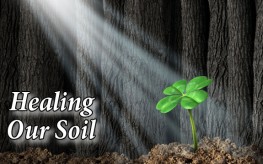4 Ways to Heal and Replenish our Damaged Soil and Food Supply

 It’s a known, disappointing fact that genetically modified foods and modern farming practices have wrecked our soil. Research coming from multiple studies reveals that Bt toxins ruin the very earth that allows such abundant plant life to grow on this planet. Earthworms and natural microbes as well as beneficial insects that help our plants grow into vital fruit and vegetable-giving sustenance are no longer looked at as viable options for farming or gardening. We have nuked the soil with pesticides and herbicides, which has largely contributed to the massive decline in our foods nutritional value.
It’s a known, disappointing fact that genetically modified foods and modern farming practices have wrecked our soil. Research coming from multiple studies reveals that Bt toxins ruin the very earth that allows such abundant plant life to grow on this planet. Earthworms and natural microbes as well as beneficial insects that help our plants grow into vital fruit and vegetable-giving sustenance are no longer looked at as viable options for farming or gardening. We have nuked the soil with pesticides and herbicides, which has largely contributed to the massive decline in our foods nutritional value.
Thinking about dirt may not be glamorous, but it is essential to organic and sustainable farming. While the soil is damaged from GMO, it may not be irrevocable – yet. But we need to act soon if we want to save our soil and the food supply.
Research from New York University says that Bt toxins actually accumulate in soil by binding to humic acid in soil particles. Usually, the microbes in soil degrade free toxins (those which occur naturally), but with Bt toxins, they endure so that they can retain their capacity to kill insects. This, in turn, causes a major problem in the soil ecosystem.
Bt toxins stay active and enter the insect’s gut, where it basically disintegrates their intestines. This is why farm animals are behaving in a similar manner when they are fed a diet of GMO corn or soy.
Good, healthy, organic soil has no Bt toxins, and no herbicides or pesticides. It is a mixture of sand clay and silt, and a host of microscopic life, which arises from dead and decaying things like leaves, other plants, etc. Real soil is part of the cycle of life. It requires cooperation with these cycles of nature in order to be healthy.
When we allow this to happen instead of eradicating all the ‘nutrients’ that are really this combination of living as well as dead and dying parts of nature, then we get healthy, prolific plants that produce bumper crops of apples, zucchini, corn, tomatoes, potatoes, spinach, cauliflower, and so much more.
4 Ways to Repair Damaged Soil
What’s more, is we can add soil amendments to help Mother Nature along instead of making it so difficult for anything to grow. Here are just a few examples of ways we can support good soil instead of using toxic chemicals:
- 1. Compost – You can turn your kitchen scraps, dead leaves, and even unbleached paper napkins into some great compost soil for your plants. If you buy yours from a local nursery instead of making it yourself and it smells like urine, then the nitrogen content is too high. If you make your own, you can make sure that the nitrogen levels are balanced with other important nutrients that should be in your soil. You can even make your own compost bin and start healing your soil today.
- 2. Leaf Humus – This is really just a different type of compost. Instead of raking up leaves and throwing them away, allow them to compost. They make a very balanced soil amendment that has balanced Ph levels to add to your garden.
- 3. Manure – Many farmers and gardeners rave about chicken poop. All animal manures should be composted for at least 90 days before putting them on plants you plan to eat. But when done right, animal manure can be great fertilizer, and it actually isn’t full of toxic chemicals.
- 4. Crop Rotation – We’ve all heard of peak oil, but less notice has been paid to peak phosphorus and potassium, two of the three key elements in agriculture that allow plants to take root and thrive. (The other element is nitrogen.) Our ancestors rotated fields to allow soil to rest after each harvest to prevent such nutrient depletion, and since the identification of these elements in the 19th century, we’ve put food and animal (sometimes human) waste back into the earth as what began to be called fertilizer in the 20th century. Respecting natural rotation and farming techniques, however, is something Big Ag hasn’t bothered to do.
The best soil amendments feed both the soil and the plants, not deplete them, and definitely don’t ruin them for generations to come as GMO crops do. Keeping this earth fertile starts with good, healthy soil.
